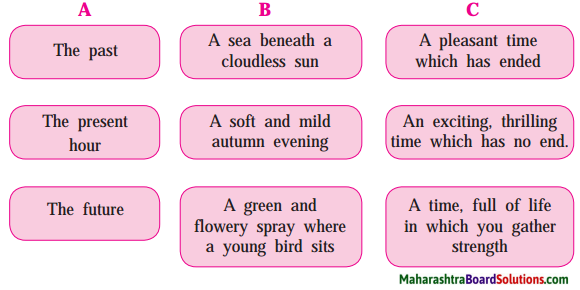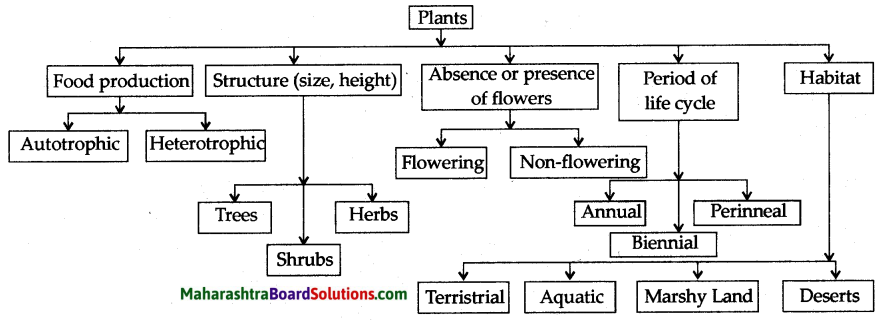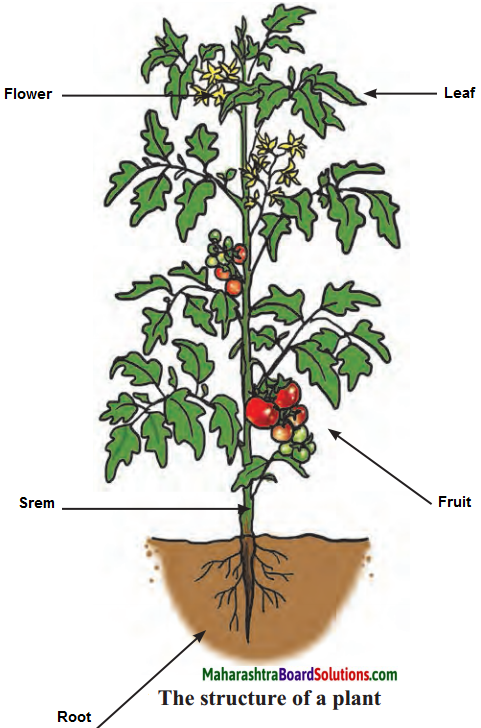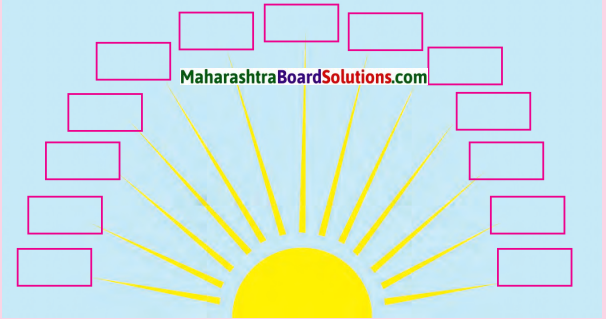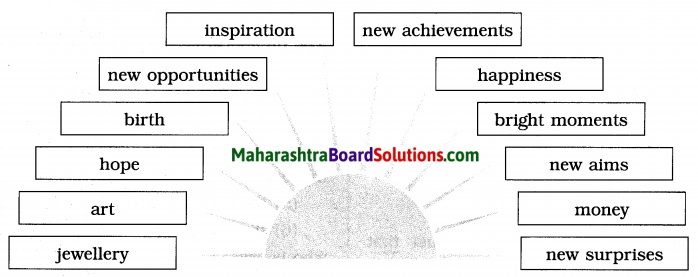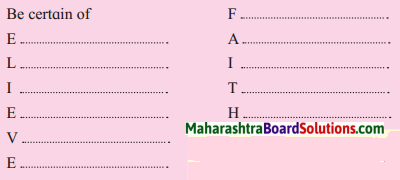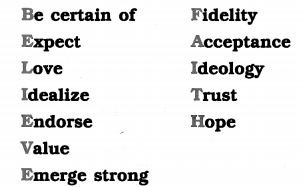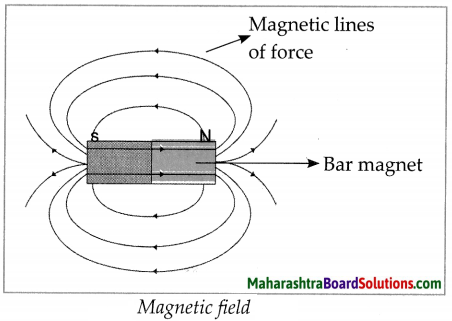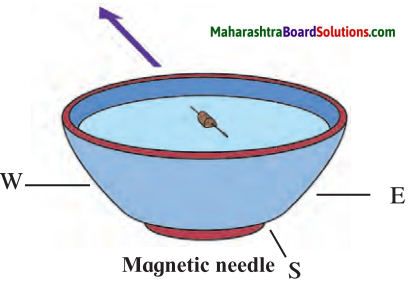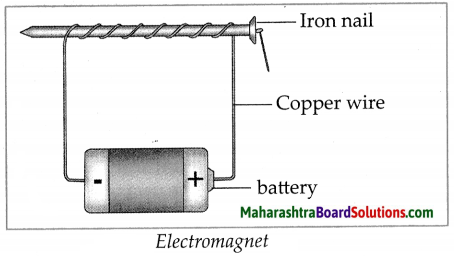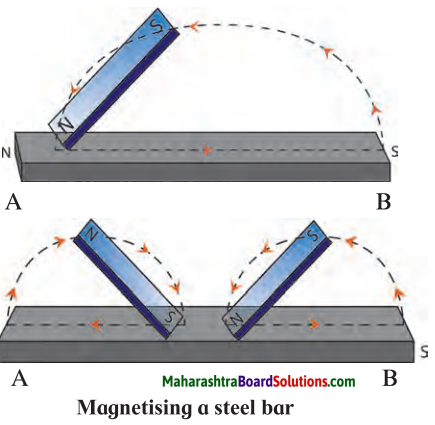Balbharti Maharashtra State Board Class 8 English Solutions Chapter 2.3 The Worm Notes, Textbook Exercise Important Questions and Answers.
Maharashtra State Board Class 8 English Solutions Chapter 2.3 The Worm
Class 8 English Chapter 2.3 The Worm Textbook Questions and Answers
Warming Up:
1. ‘Worms play a very important role; in maintaining ecological balance. They are friends of farmers.’ Form groups and discuss the significance; of worms in the above two roles.
(Point: worms – loosen the soil-bring up fertile soil-turn organic garbage into organic fertilizers-provide/proteins, etc.)
(Students can discuss this as Oral Work.)
2. Think and write down how the following creatures can be useful:
Question a.
DragonFly:
Answer:
eats mosquitoes and flies; controls unwanted insects.
![]()
Question b.
Spider:
Answer:
keeps insect population under control.
Question c.
Ants:
Answer:
turn and aerate the soil; help; in seed dispersal.
Question d.
Honeybees:
Answer:
provide honey; help in pollination.
Question e.
Earthworms:
Answer:
loosen the soil; turn organic garbage into fertilizer.
![]()
3. Little creatures in nature can also be your teachers. Think and write: what we can learn from the following:
Question a.
Bees:
Answer:
organization; hard work self-sacrifice
Question b.
Ants:
Answer:
team work hard work discipline
Question c.
Spiders:
Answer:
patience perseverance
Question d.
Caterpillars:
Answer:
patience acceptance of change
![]()
4. Breeding worms to convert organic waste into fertilizer is called Vermiculture or Vermicomposting.
Find out more about Vermiculture and how you can carry out the same in your garden/backyard to fertilize your plants at home.
(Students can attempt this on their own as a project.)
1. Read the poem aloud and you ill find some old outdated words that we do not use in everyday language now.
However, some writers poets use them to impart an old-fashioned flavour to suit the background of their write-up. Such words are called Archaic words.
Give the modem words for the archaic words from the poem.
- thy
- being
- bestow’d
- thee
- thou
- canst
Answer:
- thy – your
- being – life
- bestow’d – gifted/given as a gift
- thee – you
- thou – you
- cans’t – can
Read any poem I sonnet by William Shakespeare. Pick out archaic words and guess what they mean.
2. The poet uses a device where he directly addresses someone absent or abstarct. Such a device is the Figure of Speech called ‘Apostrophe’.
For example: Turn, turn, thy, hasty, foot aside.
Pick out any two other lines from the poem that on1uin an Apostrophe.
Answer:
(i)Turn, turn thy hasty foot aside
(ii) Let them enjoy their little day
(iii) O do not lightly take away
The life thou canst not give.
![]()
3. Think and answer in your own words ¡n your notebook:
Question a.
Why does the poet appeal to us to respect the life of worms?
OR
Why should we take care even of small worms?
Answer:
The poet urges us to remember that every creature on this earth is created by God for some purpose. We must hence respect every creature, big or small, for each has its own role to play in this universe. Besides, we have no right to lightly take away a life which we cannot give back.
Question b.
Why had God created worms? What is their ecological importance?
Answer:
Every creature on this earth is created by God for some purpose. Worms play a very important role in maintaining ecological balance. They loosen and aerate the mud and bring up fertile, nutrient-rich soil. They turn organic garbage into organic fertilizers. Their bodies provide proteins.
Thus, though they are so small, they play a huge role in maintaining ecological balance, and this is the purpose for which God created them.
Question c.
Live and let live’ is a famous proverb. Which lines from the poem support this proverb?
Answer:
The lines from the poem that support the proverb ‘Live and let live’ Eire:
(i) Turn, turn thy hasty foot aside Nor crush that helpless worm
(ii) Let them enjoy their little day
(iii) Do not lightly take away The life thou canst not give
![]()
Question d.
Does the poem urge us to protect I only worms ? What is the general message conveyed through the poem?
Answer:
Though the poem is about the worm, the general message is that God has created all the creatures on earth, big ? and small, and every creature has a role to play. All beings have equal rights over the bounties of the earth. No one can take away a life that he/she cannot give.
4. Find from the library or internet other poems composed on tiny Hing creatures. Try to understand the message in each of them.
5. ‘Even small things in nature play a big role. So protect nature!’
Frame some solgans based on the above topic.
Draft a short speech on the abose topic, which you could give at your school assembly.
Use the following steps while drafting.
(1) Greeting
(2) Salutation
(3) Self-introduction
(4) Introduction of the topic
(5) Body of the speech
(6) Conclusion
(7) Expression of gratitude to audience
Answer:
Small But Important
Respected Principal, teachers and my dear friends, Good morning. Today is 5th June, World Environment Day, and on this important day I, Smruti Kamath, would like to say a few words on the huge role played by the small things in nature.
Let me begin with the earthworm. The earthworm is rightly called the friend of the farmer for it helps the farmer in immeasurable ways. It not only loosens and turns up the soil, it converts garbage into organic fertilizer too. Those minute creatures, ants, help in aerating the soil and in seed dispersal. Bees, in addition to providing honey, are indispensable in pollination. We owe our food to the work done by these little insects. Dragonflies and spiders keep down the insect population by eating insects. Frogs and fish eat the larvae of mosquitoes.
I could go on and on, extolling the virtues and the uses of every little being on this earth. However, time does not permit me to do this, and I end my speech by requesting all of you here to understand and respect the importance and the place of every little creature on this earth. Thank you.
![]()
6. Puruphrase the poem in your own simple language. Write it down in your notebook.
Answer:
In this poem, the poet tells the reader, who is in a hurry, to turn his foot aside so that he does not crush the helpless worm. The reader may be filled with scorn and hatred for the worm, but it was created by God.
The same God who made human beings and all other things that move has also given a portion of His unlimited love to the poor worm.
God has given the sun, the moon and the stars free to all the creatures He created. The grass that grows over the earth was made for worms as well as for human beings. The poet urges the reader to allow the worms to enjoy their brief life with its humble pleasures. He tells us not to take away a life which we cannot give.
7. Frame a pointwise Analysis of the poem ‘The worm’. Use the following points.
Answer:
(a) Poem and poet: ‘The Worm’ by Thomas Gisborne.
(b) Theme: Respect every creature big or small, for each has its own role to play in this universe.
(c) Tone: Serious and thought-provoking in the imperative.
(d) Structure and stanzas: Stanzas of four lines each short lines.
(e) Rhyme and Rhythm: Rhyme scheme: abab, cdcd, and so on. The last words of the first and third line and second and fourth line of every stanza rhyme, Rhythm is smooth.
(f) Language and Imagery: Archaic language; no imagery.
(g) Figures of Speech: Apostrophe, Inversion.
![]()
Class 8 English Chapter 2.3 The Worm Additional Important Questions and Answers
Complete the following:
Question 1.
The other creations of God that are mentioned in the poem are the sun, _____.
Answer:
the moon, the stars, the earth, blades of grass and humans.
Question 2.
The thought in the last two lines is that _____.
Answer:
we have no right to lightly take away a life that we cannot give back.
Question 3.
Pick out examples of Inversion from the poem.
Answer:
(i) On that poor worm bestow’d
(ii) The sun, the moon the stars He made To all His creatures free.
![]()
Writing Skills:
Question 1.
Even small things in nature play a big role. So protect nature Frame some slogans based on the above topic.
Answer:
(i) Nurture nature and get/nurtured by nature.
(ii) All creatures great and small.
The good Lord made them all.
(iii) Take care of one and all.
All creatures great and small.
